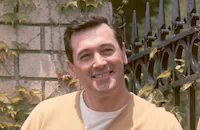A Gathering of Eagles
Brief Synopsis
Cast & Crew
Delbert Mann
Rock Hudson
Rod Taylor
Mary Peach
Barry Sullivan
Kevin Mccarthy
Film Details
Technical Specs

Synopsis
When a California Air Force base fails to pass a surprise alert test ordered by the Strategic Air Command, Col. Jim Caldwell is brought in as the new base commander. After sending for his British wife, Victoria, he goes on an inspection tour of the base to learn the cause of the test failure. Upon noting that the missile squadron commander, Col. Bill Fowler, is a heavy drinker, Jim forces him into involuntary retirement, an action that irritates Fowler's friends, including Victoria, who has become close to Fowler's wife. Furthermore, Jim's devotion to his job throws Victoria more and more into the company of Hollis Farr, Jim's vice commander and Korean War buddy. Eventually Jim decides that Hollis is too busy making friends to establish any efficiency, and he recommends that Hollis be replaced. While Jim is visiting Fowler in a San Francisco hospital, another surprise alert is called; and Hollis, obliged to assume command, makes a decision that wins commendation from the SAC. The test is so favorable that Jim and Hollis are able to patch up their differences, and Victoria at last understands why Jim has been such a stern taskmaster.

Director

Delbert Mann
Cast

Rock Hudson

Rod Taylor
Mary Peach

Barry Sullivan

Kevin Mccarthy

Henry Silva

Leora Dana
Robert Lansing

Richard Anderson
Richard Le Pore
Robert Bray
Jim Bannon
Nelson Leigh
Russ Bender
John Mckee
Ben Wright
Dorothy Abbott
John Holland
John Pickard
Ed Prentiss
Ray Montgomery
R. Wayland Williams

Leif Erickson
Crew
James Alexander
Jean Austin
Seth Banks
Sy Bartlett
Sy Bartlett
Joseph C. Behm
Teresa Brachetto
Henry Bumstead
Ray Fernstrom
Larry Germain
Joseph Gershenson
Jerry Goldsmith
Alexander Golitzen
Victor Goode
Russell Harlan
Jim Hilbert
Irene
Fred Knoth
Olive Koenitz
Rollie Lane
Joe Lapis
Tom Lehrer
Paul Mantz
Norman Mayreis
Winston E., (lieut. Col., Usaf) Moore
Robert Morrison
Terry Morse Jr.
Edward Muhl
Bill Neff
Frank Nifong
John Oliver
Foster Phinney
Robert Pirosh
Robert Priestley
Mark Reedall
Julius Rosenkrantz
Russell F. Schoengarth
Robert Schulte
Deke Smith
Frank Stanley
Norman Stuart
Waldon O. Watson
Robert D. Webb
Ernest B. Wehmeyer
James Welch
Bud Westmore
Jack Whitman

Film Details
Technical Specs

Award Nominations
Best Sound Effects Sound Editing
Articles
A Gathering of Eagles
The film was planned as something of a corrective to two other major projects in the works; one had a sharply satiric viewpoint and the other was a frighteningly realistic approach to the realities of a defense system poised for war and potential nuclear annihilation. Air Force officials, chief among them Gen. Curtis LeMay, feared the upcoming release of Stanley Kubrick's comic horror-show Dr. Strangelove (1964) and Sidney Lumet's apocalyptic Fail-Safe (1964) would undermine public confidence in the military's "positive control" of weapons of mass destruction. So it's no surprise they fully supported the efforts of producer and story creator Sy Bartlett to create a peacetime film that would have all the tension and excitement of a war story while also promoting the image of a confident, respected Air Force command. Although government officials, allegedly burned by Hollywood in several recent instances, were less cooperative with film projects that might be too free with tax dollars and with the "facts" as they saw them (or wished to present them), LeMay wielded considerable power to allow director Delbert Mann and his cast and crew extraordinary access to bases, including the use in one scene of the real "Red Phone," the device by which SAC commanders alerted all bases in the system to imminent threats and gave the go-ahead to mobilize.
The Red Phone also became the centerpiece of one of the film's highlights, a song written by Tom Lehrer, the satirical composer-lyricist who went on to create the title tune and other music for the sardonic TV news parody show That Was the Week That Was. "The SAC Song" is sung by Rod Taylor in the movie.
Mann jumped at the chance to direct A Gathering of Eagles. Although he had gotten his start with intimate, highly dramatic live TV programs in the 1950s, including both small and big screen versions of the Paddy Chayefsky hit Marty (1955), he was getting a reputation through his work at Universal as a light comedy director. Just prior to this assignment, the studio had assigned him the Rock Hudson-Doris Day romantic comedy Lover Come Back (1961) and another one that paired Day with Cary Grant, That Touch of Mink (1962). Both films had been big hits, and Mann was eager to show what he could do with vastly different material. Unfortunately A Gathering of Eagles did not fare well with either critics or moviegoers, and his next job was directing another romantic comedy, Quick Before It Melts (1964).
A Gathering of Eagles did receive one Academy Award nomination, for Best Sound Effects.
Look for a familiar face in a bit role as Mrs. Kemler. After more than a dozen TV appearances, Louise Fletcher made her feature film debut in A Gathering of Eagles. She later won the Best Actress Oscar® for her work in One Flew Over the Cuckoo's Nest (1975). Robert Lansing, who plays Sgt. Banning, went on to play a role similar to Hudson's as an Air Force base commander in the TV series Twelve O'Clock High.
Director: Delbert Mann
Producer: Sy Bartlett
Screenplay: Robert Pirosh, Sy Bartlett (story)
Cinematography: Russell Harlan
Editing: Russell F. Schoengarth
Art Direction: Henry Bumstead, Alexander Golitzen
Original Music: Jerry Goldsmith, Tom Lehrer (song: "The SAC Song")
Cast: Rock Hudson (Col. Jim Caldwell), Rod Taylor (Col. Hollis Farr), Mary Peach (Victoria Caldwell), Barry Sullivan (Col. Bill Fowler), Kevin McCarthy (Col. "Happy Jack" Kirby).
C-115m. Letterboxed.
by Rob Nixon

A Gathering of Eagles
Quotes
Trivia
Notes
Locations filmed at SAC bases and in San Francisco.

Miscellaneous Notes
Released in United States 1963
Released in United States on Video November 1998
Released in United States 1963
Released in United States on Video November 1998













